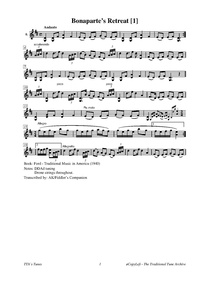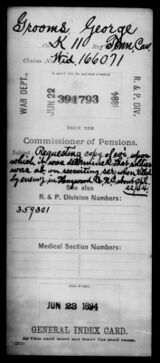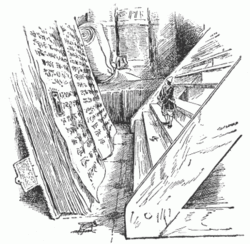TTA
|
| Welcome to The Traditional Tune Archive Development Site |

Played by: Joey Abarta
Source: Soundcloud
Image: 19th century Scottish coggie, a drinking vessel.
According to Blue Ridge Mountain local history the tune was known in the Civil War era. Geoffrey Cantrell, writing in the Asheville Citizen-Times of Feb., 23, 2000 relates the story of the execution of three men by the Confederate Home Guard on April 10th, 1865, the day after Lee's surrender at Appomattox Courthouse.
That news would not have been known to them, given the difficulty with communications at that time. It is documented that Henry Grooms, his brother George and his brother-in-law Mitchell Caldwell, all of north Haywood County, North Carolina, were taken prisoner by the Guard under the command of one Captain Albert Teague-no one knows why, but the area had been ravaged by scalawags and bushwackers, and the populace had suffered numerous raids of family farms by Union troops hunting provisions.
One theory is that the men were accused of being Confederate deserters who, perhaps knowing the war was nearly over, had aided the Union cause in some way. There was much back-and-forth guerilla warfare, however, and the village of Waynesville had been burned two months earlier (by Unionists), and the citizenry was beleaguered and anxious. Caldwell and the Grooms brothers were captured in the Big Creek section of Haywood County, close to the Tennessee border.
Cantrell writes: "The group traveled toward Cataloochee Valley and Henry Grooms, clutching his fiddle and bow, was asked by his captors to play a tune. Realizing he was performing for his own firing squad Grooms struck up Bonaparte's Retreat," his favorite tune.
When he finished the three men were lined up against an oak tree and shot, the bodies left where they fell. Henry's wife gathered the bodies and buried them in a single grave in the family plot at Sutton Cemetery No. 1 in the Mount Sterling community, the plain headstone reading only "Murdered."
The original source for the story is George A. Miller, in his book Cemeteries and Family Graveyards in Haywood County, N.C.
...more at: Jackson's Coggie - full Score(s) and Annotations
X:1 T:Jackson's Coge in the Morning M:6/8 L:1/8 S:O'Farrell's Pocket Companion Z:Paul Kinder K:Amin V:1 clef=treble name="0." [V:1] A|:E2 A A2 B|c2 A BGE|GAG AGE|G2 B GED| E2 A A2 c|BAG Bcd|ege dBG|A3 A3:| |:e2 a a2 b|c'2 g age|g2 d g2 a|b2 a ged| e2 a abc'|bag a2 e|g^fe dBG|A3 A3:||

"The charge of desertion against this man has been removed. It has been determined from evidence presented, that he was killed by the enemy, April 22, 1864, while absent on recruiting service in Haywood County, NC".
Played by: Dolly Parton
Source: Soundcloud
Image: To this day, North Carolina mountain fiddlers will refer to Bonaparte's Retreat as "Grooms' Tune".

According to Blue Ridge Mountain local history the tune was known in the Civil War era. Geoffrey Cantrell, writing in the Asheville Citizen-Times of Feb., 23, 2000 relates the story of the execution of three men by the Confederate Home Guard on April 10th, 1865, the day after Lee's surrender at Appomattox Courthouse.
That news would not have been known to them, given the difficulty with communications at that time. It is documented that Henry Grooms, his brother George and his brother-in-law Mitchell Caldwell, all of north Haywood County, North Carolina, were taken prisoner by the Guard under the command of one Captain Albert Teague-no one knows why, but the area had been ravaged by scalawags and bushwackers, and the populace had suffered numerous raids of family farms by Union troops hunting provisions.
One theory is that the men were accused of being Confederate deserters who, perhaps knowing the war was nearly over, had aided the Union cause in some way. There was much back-and-forth guerilla warfare, however, and the village of Waynesville had been burned two months earlier (by Unionists), and the citizenry was beleaguered and anxious. Caldwell and the Grooms brothers were captured in the Big Creek section of Haywood County, close to the Tennessee border.
Cantrell writes: "The group traveled toward Cataloochee Valley and Henry Grooms, clutching his fiddle and bow, was asked by his captors to play a tune. Realizing he was performing for his own firing squad Grooms struck up Bonaparte's Retreat," his favorite tune.
When he finished the three men were lined up against an oak tree and shot, the bodies left where they fell. Henry's wife gathered the bodies and buried them in a single grave in the family plot at Sutton Cemetery No. 1 in the Mount Sterling community, the plain headstone reading only "Murdered."
The original source for the story is George A. Miller, in his book Cemeteries and Family Graveyards in Haywood County, N.C.
...more at: Bonaparte's Retreat - full Score(s) and Annotations
X:1 T:Bonaparte's Retreat [1] M:C L:1/8 Q:"Andante" N:DDAd tuning N:Drone strings throughout. B:Ford - Traditional Music in America (1940) Z:AK/Fiddler's Companion K:D % V:1 clef=treble name="0." [V:1] [G,2D2] [G,D]F [D2A2]F2|(ED) (EF) (GF) (EF)|[G,2D2][G,D]F [D2A2]F2|(ED) (EF) [G,3D3]:| "accelerando"(3A/B/c/|d2 d>f d2 (3A/B/c/|(dB) (AG) (FD) (3A/B/c/|d2 d>f d[D2A2]|(FD) (EF) (GF) (EF)| [G,D][G,D]F [D2A2]F2|(ED) (EF) (GF) (EF)|[G,2D2][G,D]F [D2A2]F2|(ED) (EF) [G,3D3]z2|| (3A/B/c/|[G,2D2]d>"poco"f d2 (3A/B/c/|[G,D]>B (AG) (FD) "poco"(3A/B/c/|[G,2D2]|d>f d2A2|(F>D) (EF) (GF) (EF)| [G,2D2][GD]F [D2A2]F2|"Piu moto"(ED) (EF) (GF) (EF)|[G,2D2] {G,D]F [D2A2]F2|(ED) (EF) [G,4D4]|"Coda"[A8e8]|| M:2/4 L:1/8 "Allegro"(g/e/g/e/ bg|g/e/f/g/ a/g/f)|(g/e/g/e/ bg|1 f/e/f/g/ [A2e2]):| |2f/e/f/g/ [Ae](3A/B/c/||"Allegretto"d2 d>f d2 (3A/B/c/|(dB) (AG) (FD) (3A/B/c/|d2 d>f d2A2|(FD) (EF) (GF) (EF)|
|
Latest Tunes
Who Builds the TTAAlthough we are not trained musicologists and make no pretense to the profession, we have tried to apply such professional rigors to this Semantic Abc Web as we have internalized through our own formal and informal education.
|
Some of items in the Traditional Tune Archive may contain offensive language or negative stereotypes. Such materials should be seen in the context of the time period and as a reflection of the attitudes of the time. The items are part of the historical record, and do not represent the views of the administrators of this site. |


